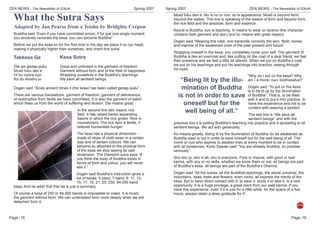
What the kesa sutra says...
- 1. ZEN NEWS - The Newsletter of IZAUKSpring 2007 Page - ZEN NEWS - The Newsletter of IZAUK Spring 2007 Page - What the Sutra Says Takkesa Ge 15 Adapted by Jan Pearse from a Teisho by Bridgitte Crépon Buddha said “Even if you have committed errors, if for just one single moment you sincerely venerate the kesa, you can become Buddha” Before we put the kesa on for the first time in the day we place it on our head, making it physically higher than ourselves, and chant this sutra: Kesa Sutra Dai sai gedap-puku Musô fuku den e Hi bu nyorai kyo Ko do shoshu jo Great and unlimited is the garment of freedom Garment without form and of the field of happiness Wrapping ourselves in the Buddha’s teachings We save all sentient beings. Dogen said “Since ancient times it (the kesa) has been called gedap-puku”. There are various translations: garment of freedom, garment of deliverance, of redemption from faults we have committed. It is also the garment of satori which frees us from the world of suffering and illusion. Dai means great. In the second line den means rice field. It has raised banks separating basins in which the rice grows. Rice is nourishment. The rice field is fertile, it relieves humanities hunger. The kesa has a physical dimension - made of strips of cloth sewn in a certain way and of certain colours. We can become so attached to the physical form of the kesa we stop seeing its vast dimension. The Diamond sutra says “If you think the body of Buddha exists in terms of form and colour, you will never see it.” Dogen said Buddha’s instruction gives a list of kesas: 5 band, 7 band, 9, 11, 13, 15, 17, 19, 21, 25, 250, 84,000 band kesa. And he adds that this list is just a summary. Of course a kesa of 250 or 84,000 bands is impossible to make. It is musô, the garment without form. We can understand form more deeply when we are detached from it. Musô fuku den e. Mu is no or non, so is appearance. Musô is beyond form, beyond the visible. This line is speaking of the weave of form and beyond form, the rice field and the absolute, form and essence. Nyorai is Buddha, kyo is teaching, hi means to wear or receive (the character contains both garment and skin) and bu means with great respect. Dogen said “Wearing this robe, one transmits correctly the skin, flesh, bones and marrow of the awakened ones of the past present and future”. Wrapping oneself in the kesa, you completely cover your self. The garment of Buddha is like an overcoat and, like putting on the coat of a dear friend, we feel their presence and we feel a little bit altered. When we put on Buddha’s coat, we put on his teachings and put his teachings into practice, seeing through his eyes. “Why do I put on the kesa? Why am I a monk/ nun/ bodhissatva?” Dogen said “To put on the kesa is to be lit up by the illumination of Buddha”. That is, to be filled with it and to put it into practice, to have the experience and not to be content with wearing a symbol. The last line is “We save all sentient beings” and with the previous line it is putting Buddha’s teaching into practice and it spreading to all sentient beings. We act with generosity. Ko means greatly. Being lit by the illumination of Buddha (to be awakened as Buddha was) is not in order to save oneself but for the well being of all. The monk or nun who aspires to awaken tries at every moment to be in contact with all existences. Kodo Sawaki said “You are already Buddha, so practise seriously”. Sho shu jo, sho is all, shu is everyone. Pure or impure, with good or bad karma, with any or no skills, whether we know them or not, all beings are part of Buddha’s kesa, all beings are part of the Buddha’s Dharma. Dogen said “All the sutras, all the Buddhist teachings, the whole universe, the mountains, seas, trees and flowers, even rocks, all express the merits of the kesa. But to have direct contact with it, to wear it, study it or sew it, is a rare opportunity. It is a huge privilege, a great merit from our past karma. If you have this experience, even if it is just for a little while, for the space of a few hours, always retain a deep gratitude for it”. 16 “Being lit by the illu- mination of Buddha is not in order to save oneself but for the well being of all.”
